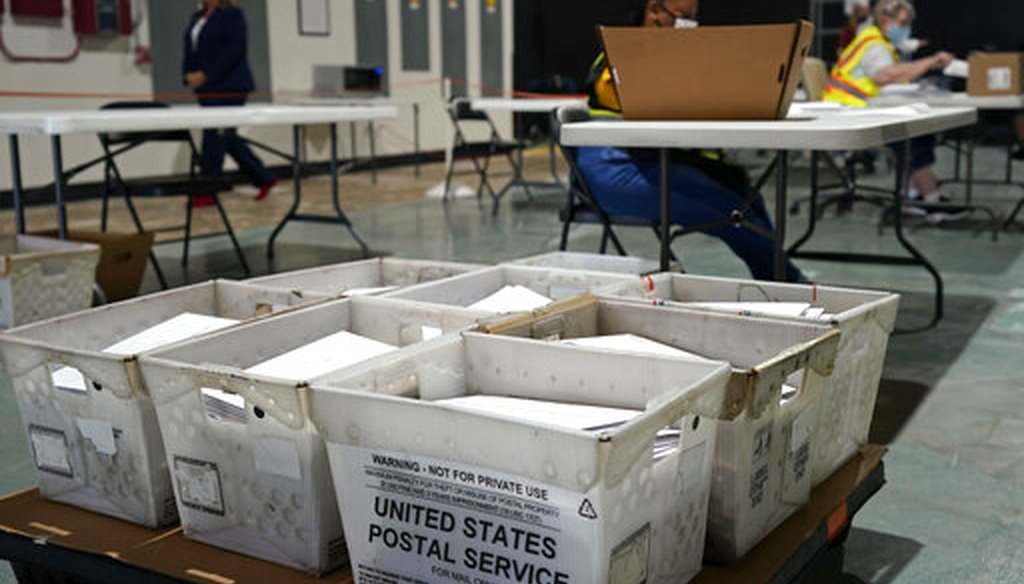Stand up for the facts!
Our only agenda is to publish the truth so you can be an informed participant in democracy.
We need your help.
I would like to contribute

Workers prepare absentee ballots for mailing at the Wake County Board of Elections in Raleigh, N.C., Sept. 3, 2020. (AP)
If Your Time is short
-
The U.S. Postal Service postcard about mail-in ballots created confusion because deadlines and policies vary from state to state. In some states, election officials are mailing ballots to all voters, so voters don’t have to request them.
-
In Colorado, the secretary of state sued USPS over the postcard and got a temporary restraining order.
The rules for voting by mail throughout the United States cannot be squeezed onto a postcard. The U.S. Postal Service just learned that the hard way.
The Postal Service mailed out a postcard across the country with tips for voting by mail. The tips, however, have drawn bipartisan criticism because some are wrong for particular states.
The postcard urges voters who plan to vote by mail to request their mail-in or absentee ballot at least 15 days before Election Day. It tells voters to "mail your ballot at least 7 days before Election Day" and to add postage to the return envelope "if needed."
But in many states this year, election officials are automatically sending out ballots to minimize crowds on Election Day.
The postcard acknowledges that "the rules and dates vary by state, so contact your election board to confirm."
The caveat did not prevent the bipartisan backlash to the mailer, well-intentioned as it might have been.
Election officials in Colorado, California, Maryland, Nevada, Rhode Island, Utah, Vermont, Washington and West Virginia criticized the USPS postcard with terms such as "misinformation," "confusing" or "not accurate" for their state.
Here’s the bottom line with the mailer’s accuracy: Generally speaking, it is a good idea for voters who are casting ballots by mail to request them and complete them early. But the timelines listed in the postcard may not apply.
We asked the USPS why it sent the same postcard nationwide despite different rules in many states. "Our mailer was intended to be general all-purpose guidance on the use of the mail, and not guidance on state rules," USPS said through a spokesperson.
RELATED: How to make sure your ballot is counted this fall
Rules about requesting and returning ballots vary from state to state
The postcard’s checklist for voting by mail instructs readers to request the mail-in ballot at least 15 days before Election Day.
That’s an unnecessary step for millions of U.S. voters this year. It’s also not a universal deadline.
Colorado, Hawaii, Oregon, Washington, and Utah will automatically send ballots to voters, as they have done for years. Because of the 2020 pandemic, California, Nevada, New Jersey, Vermont and the District of Columbia are joining them, sending ballots to all active registered voters. No request is needed in those states.
Republican Lt. Gov. Spencer Cox of Utah called the postcard "erroneous" for that reason.
Colorado Secretary of State Jena Griswold, a Democrat, tweeted that "for states like Colorado where we send ballots to all voters, the information is not just confusing, it’s WRONG." She wrote that "confusing voters about mail ballots in the middle of a pandemic is unacceptable. It can undermine confidence in the election & suppress votes. I will do everything in my power to stop @USPS from sending misinformation to voters."
Griswold won a temporary restraining order from a federal judge to stop the USPS from circulating the postcards. But by that point the postcards reached many voters.
In other states, voters do have to take action to request a mail ballot, although some of them may have taken that step already if they live in a state that allows a permanent absentee voting list.
The USPS instructs to request the ballot at least 15 days before Election Day, but that is not a universal deadline, according to our review of state deadlines.
In Florida, for example, voters who want a ballot mailed to them must request one by 5 p.m. on the 10th day prior to an election, which this year is Oct. 24. (There are alternative procedures and timelines if you want to go in person to pick up that ballot; this is an option President Donald Trump has used.)
The best way for voters to check the deadline to request a ballot in their state — if they need to request one — is to check the website of their state or local elections office. FiveThirtyEight, the Wall Street Journal and US News have compiled the deadlines in every state.
Amid news reports about mail delays and the expected deluge of voting by mail this year, some election officials have urged voters to request ballots well in advance of the deadlines listed in law. In Wisconsin, the legal deadline to request a ballot is Oct. 29, but state officials don’t want voters to wait that long.
"In all of our voter education materials we are emphasizing the importance of requesting an absentee ballot as soon as possible, and not emphasizing the Oct. 29 deadline," said Reid Magney, spokesperson for the Wisconsin Elections Commission.
Other points that vary by state
The USPS postcard said that voters should mail their ballot at least seven days before Election Day. State laws don’t generally tell voters when to stick their ballot back in the mail, instead they set deadlines for when ballots must be received by election officials in order to be counted. Election officials can’t promise voters how long it will take the post office to deliver their ballot, which is why they have encouraged voters to complete and turn them in early. (Overseas voters are encouraged to return their ballot as soon as they receive it.)
Whether voters need to affix a stamp on their ballot can vary from jurisdiction to jurisdiction, even within a state. The office of Hillsborough County Supervisor of Elections Craig Latimer, the president of the statewide association of election supervisors in Florida, told us that many counties are paying return postage this election cycle, not but all. (Hillsborough has paid the return postage for many years.)
In some states, voters get mail ballots with prepaid postage. In other states, voters might need two or more stamps to mail their ballots. The Postal Service has repeatedly said it will deliver ballots even if they lack sufficient postage.
How to check the rules on mail in voting for your state
Then there’s an issue of what the postcard leaves out: how voters can keep tabs on their ballot.
Some state or local election offices have online ballot tracking so voters can check on the state of their vote. If a jurisdiction doesn’t have that option, voters can call their local elections office and ask if their ballot has been received. (If you vote by mail, election officials advise that you should not go to in person voting sites to try to confirm your ballot was received, as that will clog up the lines.)
The USPS postcard also omits that in many jurisdictions, voters don’t have to stick their completed ballot in the mail. They can drop them off at a designated ballot drop box.
PolitiFact California staff writer Chris Nichols contributed to this report.
Our Sources
CNN, Bipartisan officials from several states rebuke USPS' inaccurate election mailers, Sept. 14, 2020
Fivethirtyeight, How To Vote In The 2020 Election: A state-by-state guide to voting in the age of COVID-19, 2020
National Vote at Home Institute, It’s Election Day, do you know where your ballot is? Sept. 9, 2020
National Conference of Legislatures, VOPP: Table 12: States With Postage-Paid Election Mail, Sept. 14, 2020
MSN, USPS sends postcards encouraging voters to 'make a plan' for mail-in ballots, Sept. 11, 2020
Colorado Secretary of State Jena Griswold, Twitter thread, Sept. 11, 2020
Nevada Secretary of State Barbara Cegavske, Secretary Cegavske Issues Statement in Response to USPS Postcard, Sept. 12, 2020
J Schwab, Chief Deputy California Secretary of State, Tweet, Sept. 11, 2020
Maryland State Board of Elections, Maryland State Board of Elections Issues Statement on USPS Postcard, Sept. 14, 2020
Rhode Island Secretary of State, Statement by Secretary of State Nellie Gorbea on Elections Postcards sent by United States Postal Service, Sept. 13, 2020
ElectionsUtah, Tweet, Sept. 14, 2020
Utah Lt. Gov. Spencer J. Fox, Tweet, Sept. 14, 2020
Vermont Secretary of State, Tweet, Sept. 14, 2020
Washington Secretary of State, Secretary of State: Registered voters in Washington do not need to request a mail-in ballot, SEpt. 11, 2020
CPR, Colorado Secretary Of State Sues US Postal Service Over Election Mailer, Sept. 12, 2020
Florida, Vote by mail, 2020
Wisconsin Elections Commission, Wisconsin Voting Deadlines and Facts for November 2020, Aug. 20, 2020
PolitiFact California, U.S. Postal Service postcard causes confusion about mail-in voting in California, Sept. 11, 2020
PolitiFact California, How Early Should You Send In Your Mail-in Ballot To Make Sure It Gets Counted? It Varies By State, July 28, 2020
PolitiFact, Postal service says its policy is to deliver even mail ballots lacking postage, July 23, 2020
Email interview, Martha Johnson, U.S. Postal Service spokesperson, Sept. 15, 2020
Email interview, Reid Magney, spokesperson for the Wisconsin Elections Commission, Sept. 15, 2020
Email interview, Gerri Kramer, spokesperson for Hillsborough County Supervisor of Elections /president of the Florida Supervisors of Elections Craig Latimer, Sept. 15, 2020
Email interview, Patrick Gannon, North Carolina State Board of Elections spokesperson, Sept. 15, 2020












































